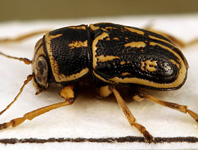Abstract
All life stages of Mortogenesia mesopotamica (Morton, 1921) are described, on the basis of material collected in the lower Euphrates–Tigris River basin. Adults are redescribed, and larvae are described for the first time, based on sets of larval exuviae. The monotypic genus Mortogenesia Lestage, 1923 is redefined using both adult and larval characteristics: eyes not contiguous, distinctly separated by a wide gap; vestigial mandibular tusks present, with 3–4 rounded lateral projections; forewing veins MP1 and iMP not brought together; CuA furcation absent on forewing; both claws similarly shaped in males; hind tarsi five-segmented; penes with roughly triangular, apically rounded and divergent lobes (in adults); seven conspicuous stout teeth on outer margin of mandibular tusk, with no apical spine-like setae; maxillary palps two-segmented; distal segment of labial palps asymmetric and bulbous; basal segment of labial palps densely pilose; forelegs with relatively short, triangular claws that are basally wider than tarsi; foretibiae with stout spines only; and a simple, leaf-like gill 1 (in larvae). The burrowing larvae of M. mesopotamica occur solely in large permanent lowland rivers, in clayey or muddy sediments, with particles exceeding 0.025–0.075 mm. Based on observations of their burrows, larval density is approximately 100–200 individuals per square meter. Various evidence suggests a unique phenomenon of male neoteny in Mortogenesia. Preliminary results of male dissections suggests a missing teneral adult cuticle, and male “subimagoes” and females occur simultaneously after oviposition. Mortogenesia mesopotamica is known currently from the Euphrates–Tigris basin in Iraq and from the Karkheh River in Iran.

